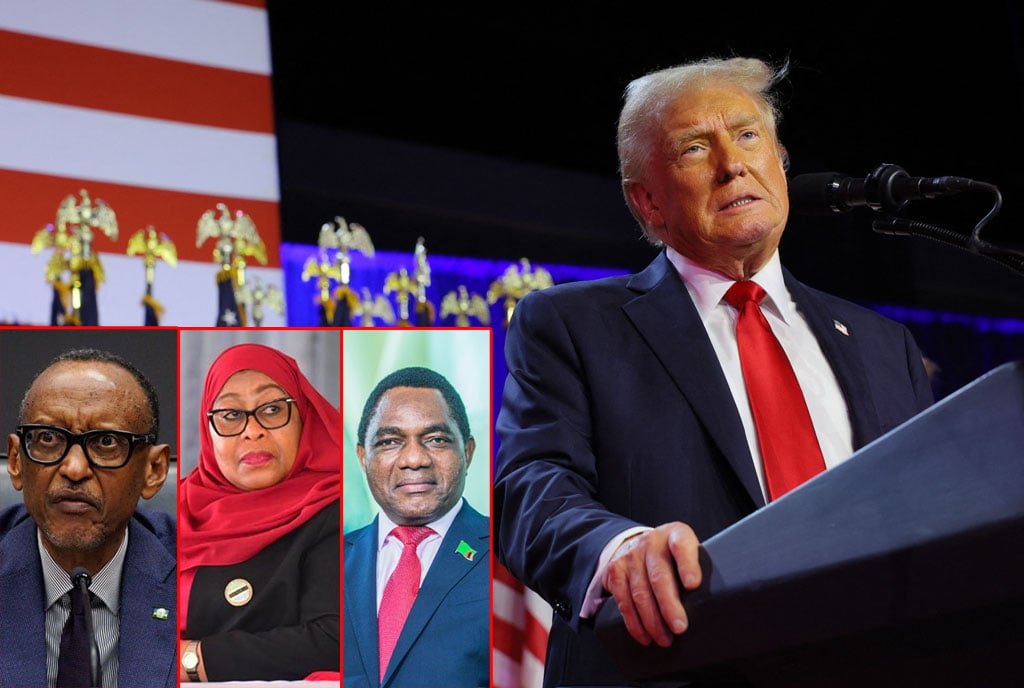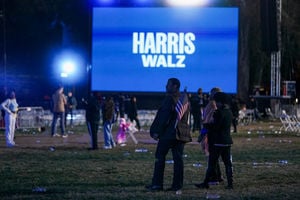Prime
Former vice president Muwanga, ministers Kayiira and Lwanga arrested

Arrested. An illustration of former Energy minister Andrew Kayiira being arrested. ILLUSTRATIONS BY IVAN SENYONJO
What you need to know:
- The real reason for the arrests and detention remains a subject of much speculation, but the head of Military Intelligence at the time, Mugisha Muntu, indicated that the arrests were linked to an attempt by a section of Baganda army officers and politicians to overthrow the government.
Today, October 6, marks 33 years and two days since security operatives made swoops in three different locations, arresting two ministers in the broad-based government, Andrew Kayiira of Energy and his Environment counterpart David Lwanga, and Milton Obote’s former vice president Paulo Muwanga.
The trio was arrested on October 4, 1986.
Paulo Muwanga, who joined politics in the late 1950s, had served as a Member of Parliament between 1962 and 1964, before serving as Uganda’s High Commissioner to Egypt and later ambassador to France.
Even after the coup that brought Idi Amin to power in January 1971, Muwanga stayed on as Uganda’s point man in France until the middle of 1972 when he absconded, before fleeing into exile in Britain.
He participated in the Moshi Conference of 1979, before returning to Uganda as minister of Internal Affairs in the short-lived regime of Prof Yusuf Lule and later minister of Labour under president Godfrey Binaisa.
Powerful man
Prior to his appointment as minister of Labour, president Binaisa had tried to force him to return to the Diplomatic corps, but Muwanga, who was a member of the interim parliament then, the National Consultative Council (NCC), had the NCC prevail over Binaisa and reverse the decision. Little did Binaisa or any member of the NCC know that Muwanga was on his way to becoming one of the most powerful men in Uganda for the next five years.
In May 1980, Binaisa made an attempt to reshuffle the Cabinet and shake up the army leadership. The move was an attempt to relocate David Oyite-Ojok, one of the most influential commanders of the Kikosi Maalum, a fighting group loyal to the then exiled Milton Obote. The result was the coup of May 12, 1980, in which Binaisa was deposed.
A six-man Military Commission was appointed to lead the country and Muwanga, as its chairman, assumed the presidency for about 10 days until the Presidential Commission of Uganda was formed and assigned the task of steering the country. Muwanga as chairman of the Commission, held the powers of the president between May 22 and December 15, 1980.

An illustration of former vice president Paulo Muwanga in detention.
When elections were called for December 10, 1980, Paulo Muwanga appointed himself chief of the Independent Electoral Commission, which declared Uganda Peoples Congress (UPC) candidate, Obote, winner of the controversial elections.
Yoweri Museveni, who had contested in the elections on the Uganda Patriotic Movement (UPM) ticket, cried foul and took to the bush to fight the elected government.
Obote repaid the favour by appointing Muwanga his vice president and minister of Defence, posts that he held until July 1985 when the army led by generals Tito Olara Okello and Bazilio Olara Okello ended Obote’s second stint in power.
As Obote’s number two, Muwanga, built himself quite a formidable power base in both Cabinet and other sections of government, including the army.
Most of the Cabinet ministers from Buganda and others from some of the Bantu-speaking tribes paid allegiance to him. He was feared among some of his boss’ erstwhile allies like the then all powerful minister of Internal Affairs, Dr Luwuriza Kirunda. A former member of the Luwuriza Kirunda’s inner circle, Patrick Miyingo, recently revealed how Kirunda was forced to temporarily flee into exile until Muwanga had cooled down.
“I don’t remember what it was that caused the tensions between them, but Kirunda was forced to flee to Nairobi [Kenya] for about a week until Muwanga had cooled down. He only returned after Obote had intervened in the matter. Even then, he had to apologise to Muwanga,” he said.
Muwanga was believed to have assembled a personal militia commonly known as the “UD boys”. Most of the UD boys were said to be recruits from central Buganda, who would be relied upon when needed to deal with any threats from colleagues he did not trust.
Following the ouster and subsequent flight into exile of Obote, Muwanga was named executive prime minister under Tito Okello, but was replaced late in August 1985 by the late Abraham Waligo.
Kayiira and Lwanga
Kayiira, who was the minister for Energy, was on his part arrested from near Tank Hill, Muyenga, while David Livingstone Lwanga, who was the minister in charge of the Environment, was picked up as he made his way to Luweero.
A day before, officers attached to the Chieftaincy of Military Intelligence had swung into action and arrested six former commanders of the Uganda Freedom Movement (UFM) and Federal Democratic Movement of Uganda (FEDEMU), who had convened a meeting at Colline Hotel in Mukono.
However, long before then, there had been quite a number of arrests of former fighters of both FEDEMU and UFM in what appeared to be calculated purges.
Ironically, FEDEMU had been a part of Andrew Kayiira’s UFM, but a group of predominantly Ganda nationalists, whose main interest was to introduce federalism, quit to form FEDEMU with Lwanga as chairman and Capt George Nkwanga and Maj Gen Kasirye Gwanga were in charge of the fighting groups.
Nkwanga was killed under mysterious circumstances a few days before the NRM took power. Some people, however, suspect that he was killed by the late Gen Bazilio Okello. Okello reportedly summoned him for “an urgent meeting” after he had discovered that Nkwanga, who had, together with UFM, earlier joined the Tito Okello government, had now allied themselves to the National Resistance Army (NRA) which was rapidly advancing to Kampala.
The exact cause of the split remains a subject of conjecture. In an interview that he gave sections of the local media in January 2007, the former senior presidential advisor on defence and coordinator of Security Agencies, Gen David Sejusa, suggested that the UFM leadership had been plagued by personal and ideological differences right from inception.
“They couldn’t see eye-to-eye, couldn’t even talk to each other. We were the ones who were standing between them. They had political and financial problems,” Gen Sejusa said.
However, in his book, Social Origins of Violence in Uganda, 1964-1985, Prof ABK Kasozi indicates that FEDEMU was formed following the disintegration of UFM’s military leadership in Uganda.
“After the September 1982 disaster, remnants of the former UFM soldiers regrouped and constituted FEDEMU. Lawrence Ssemakula, a former NRA member, became its first leader. Ssemakula was, however, abducted from Nairobi and later died in custody. Dr Lwanga remained the head of the movement, while Nkwanga, alias Mupakasi, became the head of the military wing. FEDEMU was actually the UFM rejuvenated after its demise in September 1982,” Prof Kasozi writes.

Former president Godfrey Binaisa.
Why the arrests?
The real reason for the arrests and detention remains a subject of much speculation, but the head of Military Intelligence at the time, Mugisha Muntu, indicated that the arrests were linked to an attempt by a section of Baganda army officers and politicians to overthrow the government.
The attempted coup was allegedly unearthed in September following the arrest of former fighters of the two groups, who had earlier been integrated into the NRA and deployed in Kitgum, Gulu, Lira and Tororo districts. The most notable arrests were those of Capt Godfrey Nsereko, a former chief bodyguard of Capt George Nkwanga, and that of Maj Fred Kiberu, alias Mpiso.
Also picked up were Moses “Drago” Nyanzi, John Sserunkuma, Warrant Officer II Dennis Ssebugwawo, one commander Muchwa, Sgt Mohammed Kanyike, Joseph Kyabaggu and Sgt Rajab Kasozi.
The police had earlier searched the home of a traditional healer, a one Sabiiti Matovu, where they reportedly recovered 15 rifles, eight empty magazines and several barrels of diesel.
A day after the arrest of the former vice president, military intelligence carried out more swoops and picked up the minister of Commerce, Evaristo Nyanzi, as he was preparing to board a flight to Yugoslavia; the editor of The Citizen newspaper, Anthony Ssekweyama, the vice-chairman of the UFM, Francis Bwengye, Dr Charles Lwanga, an obstetrician at Rubaga Hospital; Joseph Musaka-Mubiru and Joseph Ssozi-Ntambi.
State-run Radio Uganda said Ugandan security authorities arrested Nyanzi for subversion, specifically ‘activities calculated to disturb security.’
The police was at the time quoted saying the two Cabinet ministers and former vice president had links with Ugandan rebel forces that were attacking government troops in the north from alleged sanctuaries inside Sudan.
Between May and June 1986, former FEDEMU fighters who had been deployed in the north had been accused of carrying out numerous crimes, including killing of civilians in Namukora, the home town of the late former president, Gen Tito Okello, which partially resulted into the formation of the Uganda People Democratic Army (UPDA). UPDA launched its first attack on Ukuti village in August 1986.
Following the attack, 84 people were arrested and placed at the back of a truck for onward transfer to Namukora. Some of the detained civilians attempted to escape from the truck, prompting soldiers who were following in a pickup truck to open fire, killing most of them. What has since come to be known as the Namukora massacre was interpreted to be an act of sabotage against the NRM/A.
New Vision reported that all the 26 suspects would be charged with treason. Their trial began in August 1987 and ended in March 1988 with three convictions. The high ranking prisoners like Kayiira, Lwanga, Nyanzi or Muwanga were, however, not convicted.
Kayiira was killed under mysterious circumstances shortly after his release from Luzira in 1987, while Muwanga and Lwanga died of natural causes.
About Muwanga
As Obote’s number two, Muwanga, built himself quite a formidable power base in both Cabinet and other sections of government, including the army.
Most of the Cabinet ministers from Buganda and others from some of the Bantu-speaking tribes paid allegiance to him. He was feared among some of his boss’ erstwhile allies like the then all powerful minister of Internal Affairs, Dr Luwuriza Kirunda.




